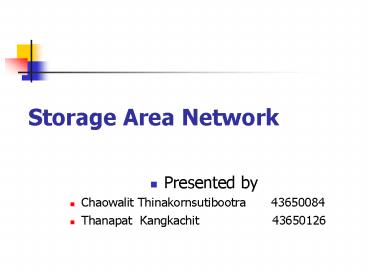Storage Area Network - PowerPoint PPT Presentation
1 / 32
Title:
Storage Area Network
Description:
Host Bus Adapter. Cable and Connector. Hubs and Switches ... Video Editing Workstations. 100 MB/s Link. Case Study : ISP. SAN Management. Seperates into 3 class ... – PowerPoint PPT presentation
Number of Views:317
Avg rating:3.0/5.0
Title: Storage Area Network
1
Storage Area Network
- Presented by
- Chaowalit Thinakornsutibootra 43650084
- Thanapat Kangkachit 43650126
2
What is SAN?
- SAN -gt Storage Area Network
- Is a dedicated nework for sharing resources.
- Provides accelerated data access and supports
advanced shortage management.
3
Problem
- The limitations loom over surge data
- The rise of client networking, data-centric
computer applications and electronic
communication applications - Parallel SCSI bus is imposing severe limits on
network storage.
4
Problem
- Impending limitations of existing server
connectivity - Bandwidth to service clients and maintain data
availability - Scalability for long term, rapid grow
- Flexibility to provide optimim balance of server
and storage capacity - Manageability for ease of installation and
maintainablity
5
The solution SAN
- Is a platform which interconnects servers and
storage at Gigabuad speeds. - Combining LAN networking models with core
building blocks of server performance and
massstroage capacity.
6
Benefits
- Is a platform which interconnects servers and
storage at Gigabuad speeds. - Combining LAN networking models with core
building blocks of server performance and
massstroage capacity.
7
The solution SAN
- Is a platform which interconnects servers and
storage at Gigabuad speeds. - Combining LAN networking models with core
building blocks of server performance and
massstroage capacity.
8
SAN Architecture
- The SAN architecture uses the Fibre Channel (FC)
interface to provide flexibility that allows the
SAN to do storage networking.
9
What is Fibre Channel?
- Fibre Channel is an industry-standard interface
adopted by the American National Standards
Institute (ANSI) and International Organization
for Standardization (ISO). Fibre Channel
transports data at 100 Mbytes (1 gigabit) per
second. In addition, Fibre Channel supports
high-speed system and network interconnects using
a wide variety of popular protocols, including
TCP/IP, FDDI, and ATM, as well as SCSI.
10
Fibre Channel Layer
- Physical Layer
- FC-0 defines physical media and transmission
rates. These include cables and connectors,
drivers, transmitters, and receivers. - FC-1 defines encoding schemes. These are used to
synchronize data for transmission. - FC-2 defines the framing protocol and flow
control. This protocol is self-configuring and
supports point-to-point, arbitrated loop, and
switched topologies.
11
Fibre Channel Layer
- Upper Layers
- FC-3 defines common services for nodes. One
defined service is multicast, to deliver one
transmission to multiple destinations. - FC-4 defines upper layer protocol mapping.
Protocols such as FCP (SCSI), FICON, and IP can
be mapped to the Fibre Channel transport service.
12
(No Transcript)
13
SAN Component
14
SAN Interconnect
Host Bus Adapter
Cable and Connector
Hubs and Switches
15
Topology
- Point - To - Point
- Fibre Channel -Arbitrated Loop
- Fibre Channel Switching
16
Point - To - Point
- topology consists of a single connection between
two nodes. All the bandwidth is dedicated for
these two nodes.
17
Fibre Channel -Arbitrated Loop
- In the loop topology, the bandwidth is shared
between all the nodes connected to the loop. The
loop can be wired node-to-node.This is overcome
by using a Fibre Channel hub. This Topology
resembles Token Ring or FDDI
18
Fibre Channel Switching
- A Fibre Channel switching topology uses either a
single Fibre Channel hub or switch or multiple
interconnected switches and hubs to facilitate
communications between nodes.
19
Comparing Fibre Channel Topologies
20
Design and Case Study
21
Traditional Storage Network System
Workstation
Tape Library
Ethernet Switch
Workstation
Workstation
Server
Disk Array
Workstation
22
Storage Area Network
Server
FC Switch
Ethernet Switch
Hub
Workstation
Disk Array
Tape Library
Workstation
Workstation
Workstation
23
Case Study Video Editing
24
Case Study ISP
25
SAN Management
- Seperates into 3 class
- SAN Storage Level
- SCSI Enclosure Service (SES)
- SAN Network Level
- Simple Network Management Protocol (SNMP)
- SAN Enterprise Systme
- Web Based Enterprise Management (WBEM)
- Common Interface Model (CIM)
26
SAN Benefits
- Pooling Solution
- Disk pooling and Tape pooling
27
SAN Benefits
- Server Clustering
28
SAN Benefits
- Backup and Recovery solutions
- LAN-less data movement
29
SAN Benefits
- Disaster Backup and Recovery
30
Next Generation of SANs
- 2 Solutions
- Fiber Channel Over IP or Storage tunnelling
- SAN over IP
31
SAN over IP
- The SoIP BluePrint
32
Fiber Channel Over IP
- Encapsulate FC frame into IP frame
33
SAN over IP
- SoIP Switch Traffic flow
34
SAN over IP
- Natvie IP SANs
35
Any question ?































